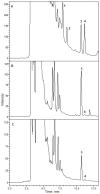Detection of Dinophysistoxin-1 in Clonal Culture of Marine Dinoflagellate Prorocentrum foraminosum (Faust M.A., 1993) from the Sea of Japan
- PMID: 26426049
- PMCID: PMC4626713
- DOI: 10.3390/toxins7103947
Detection of Dinophysistoxin-1 in Clonal Culture of Marine Dinoflagellate Prorocentrum foraminosum (Faust M.A., 1993) from the Sea of Japan
Abstract
For the first time the presence of dinophysistoxin-1 (DTX-1) in a culture of Prorocentrum foraminosum was revealed in cells and in the culture medium. The clone was isolated from coastal waters of the Sea of Japan and identified by molecular analyses of SSU and D1/D2 regions of LSU rDNA. The concentration of DTX-1 in cells was 8.4 ± 2.5 pg/cell and, in cell-free media, 27.9 ± 14.7 µg/L. The toxin presence was confirmed by HPLC with high-resolution tandem mass-spectrometry.
Keywords: DTX-1; HPLC-HRMS; Prorocentrum foraminosum; Russia; molecular identification.
Figures





References
-
- Vershinin A., Moruchkov A., Morton S., Leighfield T., Quilliam M., Ramsdell J. Phytoplankton composition of the Kandalaksha Gulf, Russian White Sea: Dinophysis and lipophilic toxins in the blue mussel (Mytilus edulis) Harmful Algae. 2006;5:558–564.
-
- Morton S., Vershinin A., Laurinda L.S., Leighfield T.A., Pankov S., Quilliam M.A. Seasonality of Dinophysis spp. and Prorocentrum lima in Black Sea phytoplankton and associated shellfish toxicity. Harmful Algae. 2009;8:629–636. doi: 10.1016/j.hal.2008.10.011. - DOI
-
- Orlova T., Morozova T., Kameneva P., Shevchenko O. Harmful algal blooms on the Russian east coast and their possible economic impacts. PICES Sci. Rep. 2014;47:41–58.
Publication types
MeSH terms
Substances
LinkOut - more resources
Full Text Sources
Other Literature Sources
Molecular Biology Databases

